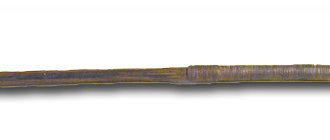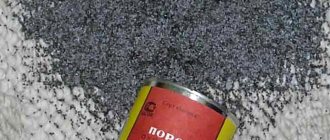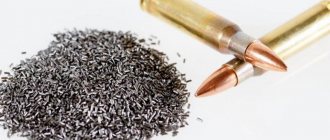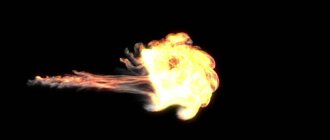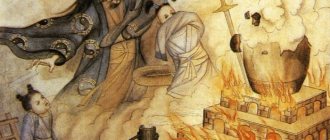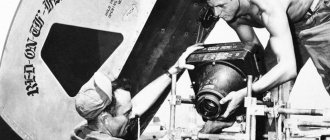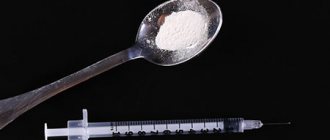Background to the appearance of gunpowder
For a long time, debates raged about when gunpowder was invented. Some attributed the recipe for the flammable substance to the Chinese, others believed that it was invented by Europeans, and only from there did it come to Asia. It is difficult to say with an accuracy of one year when gunpowder was invented, but China must definitely be considered its homeland.
Rare travelers who came to China in the Middle Ages noted the local residents’ love for noisy fun, accompanied by unusual and very loud explosions. The Chinese themselves were very amused by this action, but the Europeans inspired fear and horror. In fact, it was not gunpowder yet, but simply bamboo shoots thrown into the fire. After heating, the stems burst with a characteristic sound that was very similar to heavenly thunder.
The effect of exploding shoots gave food for thought to Chinese monks, who began conducting experiments on creating a similar substance from natural components.
What minerals are mined in China?
China leads the world in the production of coal, iron, manganese, lead-zinc, antimony and tungsten ores, as well as wood. On the territory of the People's Republic of China, oil, gas, and uranium are also produced on a significant scale. China contains 37% of the world's reserves of rare earth metals (molybdenum, vanadium, antimony).
Interesting materials:
What is a bird with a long beak? What is radio in Apple Music? What is a technology report? What is the distance from a point to a line, grade 7? What is an equal area cube? What is the equilibrium price and how is it formed? What is division of labor and why is it needed? What is the processor bit size? What are redoubts and flushes? What is 4G LTE mode?
History of invention
It is difficult to say in what year the Chinese invented gunpowder, but there is evidence that already in the sixth century the Chinese had an idea of a mixture of several components that burned with a bright flame.
The palm in the invention of gunpowder rightfully belongs to the monks of Taoist temples. Among them there were a lot of alchemists who constantly conducted experiments to create an elixir of immortality. They combined different substances in different proportions, hoping to one day find the right combination. Some Chinese emperors were heavily dependent on these drugs; they dreamed of eternal life and did not hesitate to use dangerous mixtures. In the middle of the ninth century, one of the monks wrote a treatise in which he described almost all known elixirs and methods of their use. But this was not the most important thing - several lines of the treatise mentioned a dangerous elixir that suddenly caught fire in the hands of the alchemists, causing them incredible pain. It was not possible to extinguish the flames, and the whole house burned down in a few minutes. It is these data that can put an end to the dispute about what year gunpowder was invented and where.
Although, until the tenth and eleventh centuries, gunpowder was not mass produced in China. By the beginning of the twelfth century, several Chinese scientific treatises had appeared detailing the components of gunpowder and the concentration required for combustion. It is worth clarifying that when gunpowder was invented, it was a flammable substance and could not explode.
Other applications
Still, the main area of use of gunpowder in China was holidays. Countless fireworks, illuminations and other “funny” lights - this is what was in great demand in China, and subsequently - in enlightened Europe and the world. For the Celestial Empire, this action is not just a beautiful spectacle, but a special sacred ritual to scare away evil spirits .
As you know, there was no official religion either in Ancient China or today. Confucianism, Taoism or Buddhism are formally accepted by residents of both northern and southern regions. Their world of beliefs is still filled today with various pantheons of gods and deities, hosts of spirits, including deceased relatives up to the fifth generation. So there is someone to “fight off” every holiday, especially during the Chinese New Year.
The Chinese used to drive away spirits by setting fire to piles of bamboo. Therefore, the appearance of fireworks based on black powder made this process easier, partially safer and, undoubtedly, more colorful .
The Chinese have become true masters of fire shows, improving them over the centuries. By filling special boxes with potions, making them different in weight and length, they ensured that the sky was illuminated with motley colors with varying intensity.
Gunpowder composition
After the invention of gunpowder, the monks spent several years determining the ideal ratio of ingredients. After much trial and error, a mixture called the “fire potion” emerged, consisting of coal, sulfur and saltpeter. It was the last component that became decisive in establishing the homeland of the invention of gunpowder. The fact is that it is quite difficult to find saltpeter in nature, but in China it is found in great abundance in the soil. There are cases when it protruded onto the surface of the earth in a whitish coating up to three centimeters thick. Some Chinese chefs added saltpeter to food to improve taste instead of salt. They always noticed that when saltpeter got into the fire it caused bright flashes and intensified the burning.
Taoists knew about the properties of sulfur for a long time; it was often used for tricks, which the monks called “magic.” The last element of gunpowder, coal, has always been used to produce heat during combustion. It is therefore not surprising that these three substances became the basis of gunpowder.
Powder combustion and its regulation
Combustion in parallel layers, with the release of gaseous products, but not turning into an explosion, is caused by the transfer of heat from layer to layer and is achieved by manufacturing fairly monolithic powder elements, devoid of cracks. The burning rate of gunpowder depends on pressure according to a power law, increasing with increasing pressure, so you should not focus on the burning rate of gunpowder at atmospheric pressure when assessing its characteristics. Regulating the burning rate of gunpowder is a very difficult task and is solved by using various combustion catalysts in the powder composition. Combustion in parallel layers allows you to regulate the rate of gas formation. The gas formation of gunpowder depends on the size of the surface of the charge and its burning rate.
The surface area of the powder elements is determined by their shape, geometric dimensions and can increase or decrease during the combustion process. Such combustion is called progressive
or
digressive
.
To obtain a constant rate of gas formation or its change according to a certain law, individual sections of charges (for example, rocket charges) are covered with a layer of non-combustible materials ( armor
). The burning rate of gunpowder depends on its composition, initial temperature and pressure.
Peaceful uses of gunpowder in China
At the time gunpowder was invented, the Chinese had no idea how great a discovery they had made. They decided to use the magical properties of the “fire potion” for colorful processions. Gunpowder became the main element of firecrackers and fireworks. Thanks to the right combination of ingredients in the mixture, thousands of lights flew into the air, turning the street parade into something very special.
But one should not assume that, having such an invention, the Chinese did not understand its importance in military affairs. Despite the fact that China was not an aggressor in the Middle Ages, it was in a state of constant defense of its borders. Neighboring nomadic tribes periodically raided the border Chinese provinces, and the invention of gunpowder could not have come at a better time. With its help, the Chinese consolidated their position in the Asian region for a long time.
Europe and gunpowder
The West came to the discovery and use of black (smoky) gunpowder much later than the East. At the origins of European gunpowder history, two people are noted - the natural scientist and philosopher Roger Bacon and the monk Berthold Schwartz, respectively in the second half of the 13th and the first half of the 14th century
A description of gunpowder was published in one of Bacon’s works, but then Europe ignored such valuable information. About half a century after the Englishman Bacon, independently of him, gunpowder was accidentally invented during chemical experiments by the German Franciscan monk Berthold Schwartz (Black)
At least that's what the legend says.
In the 14th century, the invention was not left without practical application, and the name of Berthold Schwarz is associated in history not only with the discovery of gunpowder, but also with the invention of weapons using the power of gunpowder. Oriental games with fireworks did not even come to mind; the power of gunpowder was immediately channeled into military channels.
Gunpowder is an integral element that is used to load cartridges. Without the invention of this substance, humanity would never have known about firearms.
But few people are familiar with the history of gunpowder. And it turns out that it was invented completely by accident. And then for a long time they were used only for launching fireworks.
Gunpowder: First military use by the Chinese
Europeans had long believed that the Chinese did not use gunpowder for military purposes. But in fact, these data are erroneous. There is written evidence that back in the third century, one of the famous Chinese commanders managed to defeat nomadic tribes with the help of gunpowder. He lured the enemies into a narrow gorge where charges had previously been planted. They were narrow clay pots filled with gunpowder and metal. Bamboo tubes with cords soaked in sulfur led to them. When the Chinese set them on fire, thunder struck, reflected several times by the walls of the gorge. Clods of earth, stones and metal pieces flew from under the nomads' feet. The terrible incident forced the aggressors to leave the border provinces of China for a long time.
From the eleventh to the thirteenth centuries, the Chinese improved their military capabilities with the use of gunpowder. They invented new types of weapons. Enemies were overtaken by fireballs, projectiles launched from bamboo tubes, and guns launched from catapults. Thanks to their “fire potion,” the Chinese emerged victorious in almost all battles, and the fame of the unusual substance spread throughout the world.
History of black powder
Main articles: History of gunpowder
and
en:History of gunpowder
Berthold Schwarz, to whom legend credits the invention of gunpowder in Europe around 1330
It is considered established that gunpowder was invented in China, where it was known in the form of a saltpeter-gray-coal mixture around the 10th century. The widely known work of F. Engels “Artillery”, written by him for the American New Encyclopedia, contained the following lines:
| In China and India, the soil abounds in natural saltpeter, and it is quite natural that the local population became familiar with its properties early... We have no information about exactly when the special mixture of saltpeter, sulfur and charcoal became known, the explosive properties of which gave it such great importance... The Arabs borrowed saltpeter and pyrotechnics from the Chinese and Indians. |
At first, black powder was used for entertainment purposes - making funny fires and something like rockets - and only later as a substance suitable for military purposes. Thus, in 1259, the Chinese described one of the first types of weapons that used gunpowder - the “spear of furious fire.” From the Arabs who lived in Spain, familiarity with the production and use of gunpowder during the 14th century spread throughout Europe. In Europe, according to legend, the German monk Berthold Schwartz is considered the inventor of gunpowder, but, obviously, gunpowder was known before him. Thus, the English philosopher and researcher Roger Bacon (c. - c.) wrote about the explosive composition of saltpeter-sulfur-coal known to him. For over five centuries, black powder was the only propellant and explosive in the world, widely used both in artillery and explosive shells, and in rockets.
Potassium nitrate is the main component of black powder
Charcoal is the second-largest component of black powder.
Sulfur is the third component of black powder
Initially, gunpowder was a mechanical mixture of saltpeter, coal and sulfur in the form of a very fine powder. Its combustion was poorly predictable, and fine powder was also unsafe, as it often led to damage or rupture of weapon barrels. Its power also left much to be desired. The issue of increasing the power of gunpowder was solved, apparently by accident, while solving another problem - reducing the hygroscopicity of this substance. Dust-like gunpowder, which existed in the 14th and 15th centuries, became wet very quickly due to the extreme hygroscopicity of saltpeter and the large area of contact of powder particles with air. These problems were largely solved at the beginning of the 16th century, when gunpowder began to be made into granules. Saltpeter-gray-coal powder, mixed with water, was turned into a paste, which was then dried in the form of lumps and, as necessary, ground into grains. This not only increased the safety of the gunpowder, but also simplified the loading process. It also turned out that the granules explode almost twice as powerfully as pulverized gunpowder of the same mass. In addition, granular powder, unlike fine powder, did not require additional empty space in the breech of the barrel for effective ignition - the gaps between the granules were sufficient for this. As a result, the weapon's power was significantly increased. Subsequently, the granulation technique was improved; the powder mass was pressed at high pressure, and after grinding, the uneven pieces were polished, which made it possible to obtain hard, shiny granules.
Gunpowder leaves China: Arabs and Mongols begin to make gunpowder
Around the thirteenth century, the recipe for gunpowder fell into the hands of the Arabs and Mongols. According to one legend, the Arabs stole a treatise that contained a detailed description of the proportions of coal, sulfur and saltpeter necessary for the ideal mixture. In order to obtain this precious source of information, the Arabs destroyed an entire mountain monastery.
It is not known whether this was so, but already in the same century the Arabs designed the first cannon with gunpowder shells. It was quite imperfect and often maimed the soldiers themselves, but the effect of the weapon clearly covered the human losses.
"First" Chinese taikonaut
A crater located near the equator (11°S, 139°W) on the side of the Moon invisible from our planet is named after the first Chinese who wanted to fly to the natural satellite of our planet. Such an initiative was taken by the mandarin (major official) Wang-Gu (in legends and translations the spelling Wang-Tu or Wang-Hu is found).
As Qian Xuesen told it, the story was as follows. Either in the 15th or 16th centuries, one high rank built a kind of rocket based on a comfortable chair and a large kite. Along the perimeter, this structure was equipped with 47 large-caliber powder rockets. At the command of the mandarin, his servants lit the wicks, and Wang-Gu soared to the skies.
In the 5th grade they briefly talk about the ancient invention of Ancient China in history lessons. He changed the whole world.
Source
"Greek Fire": Byzantine Gunpowder
According to historical sources, the recipe for gunpowder came from the Arabs to Byzantium. Local alchemists did a little work on the composition and began to use a flammable mixture called “Greek fire”. It showed itself successfully during the defense of the city, when fire from the pipes burned almost the entire enemy fleet.
It is not known for certain what was included in the “Greek fire”. His recipe was kept in the strictest confidence, but scientists suggest that the Byzantines used sulfur, oil, saltpeter, resin and oils.
Chinese secret weapon
Many Western textbooks say that the Chinese only used this mixture for fireworks displays. But this is not true. When the Song Dynasty ruled China in 904, the military used gunpowder in battles against the Mongols. They made a weapon called fei huo (flying fire). It was an arrow with a burning tube of gunpowder attached to the barrel. These flying flaming arrows were miniature rockets. They were released into the enemy's ranks with bows, with the goal of causing horror and panic among people and horses. The Chinese also used these firecrackers to scare away evil spirits. Finally, they came to the conclusion that these powder tubes could only fly due to the energy released from the gas. This is how the first rocket appeared. At that time, this seemed like terrible witchcraft to enemy warriors who were encountering this type of weapon for the first time.
Other weapons using gunpowder during the Song Dynasty included primitive grenades, poisonous gas shells, flamethrowers and landmines. The first artillery pieces were hollow bamboo tubes from which rockets were launched. But then these pipes began to be made of cast metal. The first image of such a weapon in the Song era was made in 1127. This was a century and a half earlier than the use of artillery by Europeans.
Gunpowder in Europe: who invented it?
For a long time, Roger Bacon was considered the culprit behind the appearance of gunpowder in Europe. In the mid-thirteenth century, he became the first European to describe in a book all the recipes for making gunpowder. But the book was encrypted, and it was not possible to use it. If you want to know who invented gunpowder in Europe, then the answer to your question is the story of Berthold Schwartz.
He was a monk and practiced alchemy for the benefit of his Franciscan Order. At the beginning of the fourteenth century he worked to determine the proportions of the substance from coal, sulfur and saltpeter. After much experimentation, he managed to grind the necessary components in a mortar in a proportion sufficient to cause an explosion. The blast wave almost sent the monk to the next world. But his invention marked the beginning of a new era in Europe - the era of firearms.
The first model of the “shooting mortar” was developed by the same Schwartz, for which he was sent to prison in order to not disclose the secret. But the monk was kidnapped and secretly transported to Germany, where he continued his experiments in improving firearms. How the inquisitive monk ended his life is still unknown. According to one version, he was blown up on a barrel of gunpowder; according to another, he died safely at a very old age. Be that as it may, gunpowder gave the Europeans great opportunities, which they did not fail to take advantage of.
Discoverers
It is rightly believed that gunpowder was invented in China.
It is also believed that the Indians assisted them in this matter. The event took place 1.5 thousand years before the birth of Christ. In those days there was a lot of saltpeter in China. Often even salt was replaced with saltpeter. It became the main component of the explosive. The area is still famous for the presence of a large amount of alkalis, which are sometimes found in native form. It looks like snow flakes. The Chinese noticed that if you mix saltpeter with coal and set it on fire, small flashes will be observed during combustion. The first detailed description of saltpeter was made by the physician Tao Hung-ching. He lived in the 5th–6th centuries. As a result, this substance began to be used as a medicine. Alchemists were also interested in saltpeter and often used it in their experiments. It is said that saltpeter was not used in gunpowder mixtures until several centuries later.
Gunpowder was invented by alchemists when they wanted to create an elixir of youth // Photo: liveinternet.ru
However, gunpowder may have been invented by alchemists when they wanted to create an elixir of youth. For this purpose, they mixed together sulfur with saltpeter and dry plants. All this was set on fire during the experiment. From this very moment, opinions differ about who actually is the discoverer of the miracles of the mixture. Perhaps he was the same alchemist Ning Xu-tzu, who was looking for the elixir of life. Or maybe it was invented by Sun Si-miao. He set fire to pieces of patchwork wood and the result was a kind of “black powder.” Sometimes, during experimental processes, entire laboratories and houses burned down along with their occupants. Others noticed the unusual properties of the substance and decided to use it in a different direction. Initially, fireworks were made, but then bombs, flamethrowers and mines came into use.
The appearance of gunpowder in Rus'
Unfortunately, there are no surviving sources that would shed light on the history of the appearance of gunpowder in Rus'. The most popular version is considered to be the borrowing of an explosive recipe from the Byzantines. Whether it really was so is unknown, but gunpowder in Rus' was called “potion”, and it had the consistency of powder. Firearms were first used at the end of the fourteenth century during the siege of Moscow by Khan Tokhtamysh. It is worth noting that the guns did not have much destructive power. They were used to intimidate the enemy and horses, which, due to smoke and roar, lost orientation in space, which sowed panic in the ranks of the attackers.
By the nineteenth century, gunpowder had become widespread, but its “golden” years were still ahead.
Application
Nowadays, propellants based only on nitrocellulose are known as monobase, while cordite-like ones are known as dibase. Tri-base cordites (Cordite N and NQ) with the addition of nitroguanidine were also developed, which were originally used in the large guns of naval warships, but found their use in tank forces, and are now used in field artillery. The main advantage of three-base powders, compared to di-base ones, is the significantly lower temperature of the powder gases with similar efficiency. Prospects for the further use of gunpowders containing nitroguanidine are associated with small-caliber aviation and anti-aircraft guns that have a high rate of fire.
Smokeless gunpowder enabled the development of modern semi-automatic and automatic weapons. Black powder left a large amount of solid products (40-50% of the mass of gunpowder) in gun barrels. The main solid combustion products of black powder, polysulfides (K2Sn, where n=2-6) and potassium sulfide (K2S), attract moisture and hydrolyze to potassium alkali and hydrogen sulfide. When smokeless powders are burned, no more than 0.1 - 0.5% of solid products are formed, which made it possible to automatically reload weapons using many moving parts. It is worth considering that the combustion products of all smokeless powders contain a lot of nitrogen oxides, which increases their corrosive effect on the metal of the weapon.
Single- and double-base smokeless powders now make up the bulk of propellant explosives used in small arms. They are so common that most uses of the word "powder" refer specifically to smokeless powder, particularly when referring to handguns and artillery. Black powders are used as a propellant only in under-barrel grenade launchers, flare guns and some cartridges for smooth-bore weapons.
In some cases, for example, in a number of homemade hand grenades and improvised artillery shells, smokeless powder can also be used as a high explosive, for which the loading density is adjusted to a value corresponding to detonation, and powerful detonators are used. Unlike many explosives, a detonator cap is not required to use smokeless powder; any igniter is sufficient. The effectiveness of using smokeless powders as explosive explosives, in the event of ignition, is comparable to the effectiveness of using smokeless mine powder. When using powerful detonators (in practice, at least 400-600 g of TNT), the efficiency is at the level of most individual explosives.
Smokeless powder recipe: who invented it?
The end of the nineteenth century was marked by the invention of new modifications of gunpowder. It should be clarified that for decades inventors have been trying to improve the combustible mixture. So in which country was smokeless gunpowder invented? Scientists believe it was in France. The inventor Viel managed to obtain pyroxylin gunpowder, which has a solid structure. His tests created a sensation; the advantages of the new substance were immediately noted by the military. The so-called smokeless powder had enormous strength, did not leave a soot and burned evenly. In Russia it was received three years later than in France. Moreover, the inventors worked independently of each other.
A few years later, Alfred Nobel proposed using nitroglycerin gunpowder, which has completely new characteristics, in the manufacture of projectiles. Later in the history of gunpowder there were many modifications and improvements, but each of them was designed to spread death over vast distances.
To this day, military inventors are doing serious work to create completely new types of gunpowder. Who knows, perhaps with its help in the future they will radically change the history of mankind more than once.
History of origin
First appearance
The first information is found in 808, after the Chinese alchemist Qing Xuzi composed a substance by mixing charcoal, sulfur and other impurities with half of the saltpeter in various proportions. The resulting mixture was flammable and was later used for fireworks and incendiary bombs.
Around 850, in the same China, Zheng Yingyu first made explosive gunpowder. It was this process that was described in 1044 by Wei Boyan.
In China, various types of weapons were used that involved the use of explosives: hand grenades, mines, the first rockets. The appearance of this weapon dates back to the 11th-13th centuries. From the end of the 11th century, Chinese warriors began to use a tube closed on one side with an arrow inserted and a portion of gunpowder - the ancestor of the modern gun.
The appearance of gunpowder in Europe
The first person to describe gunpowder in Europe was the Byzantine Mark the Greek. There is a very high probability that this is a pseudonym behind which are translators and copyists of books who became owners of an Arabic book.
The exact date of composition of the Byzantine manuscript is unknown, but it dates roughly from the period between 1220 and 1300.
A monk from England named Roger Bacon is also known, who described a certain remedy made from nut coal, saltpeter and sulfur, which is capable of making sounds and releasing fire. This happened in 1242, but the Englishman did not leave a recipe.
In 1330, artillery pieces were invented. This time the palm belongs to a German monk named Berthold Schwartz. This is confirmed by the fact of the battle for the city of Cevidale between Italian and German troops, in which the latter used firearms.
Another historical fact is the Battle of Crecy between the British and French in 1346, when the Anglo-Saxons used cast bronze cannons that could fire volleys. Gunpowder was placed in the blind edge, the fuse was brought out, and a core made of lead, stone or iron was located closer to the muzzle of the cannon. The charge was ignited from the side, the substance inside the gun exploded and, due to the expansion of gases, the core was ejected.
In the 19th century, smokeless gunpowder was invented almost at the same time: first, in 1884 in France, Paul Viel invented the pyroxylin variety, then 4 years later, Alfred Nobel invented the ballistic version, and a year later, Frederick Abel and James Dewar from England received the cordite version.
Obtaining gunpowder in Russia
This substance first reached Russia only in 1389. The first gunpowder factories in the country appeared only in the 15th century; they produced a smoky powder substance for shooting. Lumps were formed from it, thanks to which the charge was carried out more easily and gave more gases, that is, it increased the force of the shot.
In the middle of the 15th century, a grained version of gunpowder was invented, when it was rolled out in combination with an alcohol mixture into a dough-like mass and then passed through a sieve.
In 1748, Mikhail Lomonosov conducted experiments and tests of black powder, later continued by the French Antoine Lavoisier and Marcelin Berthelot.
"First" Chinese taikonaut
A crater located near the equator (11°S, 139°W) on the side of the Moon invisible from our planet is named after the first Chinese who wanted to fly to the natural satellite of our planet. Such an initiative was taken by the mandarin (major official) Wang-Gu (in legends and translations the spelling Wang-Tu or Wang-Hu is found).
As Qian Xuesen told it, the story was as follows. Either in the 15th or 16th centuries, one high rank built a kind of rocket based on a comfortable chair and a large kite. Along the perimeter, this structure was equipped with 47 large-caliber powder rockets. At the command of the mandarin, his servants lit the wicks, and Wang-Gu soared to the skies.
In the 5th grade they briefly talk about the ancient invention of Ancient China in history lessons. He changed the whole world.
Source
